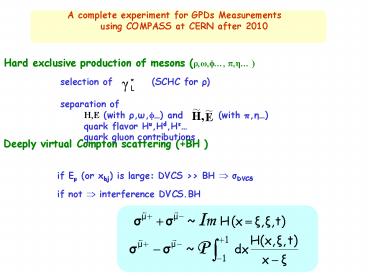A complete experiment for GPDs Measurements PowerPoint PPT Presentation
1 / 19
Title: A complete experiment for GPDs Measurements
1
A complete experiment for GPDs Measurements
using COMPASS at CERN after 2010
Hard exclusive production of mesons (?,?,?,
p,? ) Deeply virtual Compton
scattering (BH )
2
Deeply Virtual Compton Scattering Beam Charge
Asymmetry (BCA) measured with the 100 GeV muon
beam at COMPASS
BCA
Q24?0.5 GeV2
x 0.05 0.02
?
µ
?
?
µ
p
f
BCA
Eµ 100 GeV
x 0.10 0.03
Q2 4 GeV2 x 0.10
?25 realistic?
?
f
3
Complementarity of the experiments in the world
E190, 100GeV
Valence quarks
Valence and sea quarks And Gluons
0.0001lt xBj lt 0.01 Gluons
JLab
Hermes COMPASS
H1 and ZEUS
4
General requirements The highest
luminosity Nµ2.108 per SPS cycle (Radio
Protection limit) duration 5.2s
repetition each 16.8s With a new 2.5m long
liquid hydrogen target ? L1.3 1032
cm-2s-1 In 2011, with the Linac4 what could be
the limitation? What is the impact of an
increased intensity
on the detectors?
5
- Precise absolute luminosity measurement
- With NMC it has been achieved within a 1
accuracy - The integrated muon flux is measured continously
by 2 methods - By sampling the beam with a random trigger (a
emitter Am241) - By sampling the counts recorded in 2 scintillator
hodoscope planes - used to determine incident beam tracks
- The beam tracks are recorded off-line, in the
same way as - the scattered muon tracks to determine the
integrated usable muon flux - To test again for meson production
6
µ and µ- beams
- Solution proposed by Lau Gatignon
- To select Pp110GeV and Pµ100GeV
- to maximise the muon flux
- To keep constant the collimator
- settings which define
- the p and µ momentum spreads
- (fixed Collimators 1H and 3H and
- Scrapers 4V and 5V)
- ? Pol µ-0.8 and Pol µ-0.8
- To fix Nµ-2.108 per SPS cycle
- with the 500mm Be T6 target
- To use a shorter target to find also
- Nµ2.108 per SPS cycle
Requirements -same energy -same and maximum
intensity -opposite polarisation to a few
Collimators 1 2 3 4 H V H V
scrapers
T6 primary target
Na58 target
Be absorbers
Protons 400 GeV
Muon cleaning section 400m
Hadron decay section 600m
7
Necessity to complete at large angle the
high resolution COMPASS spectrometer
µ
Deeply Virtual Compton Scattering µp ? µp?
? ?? ? 10
p
µ
By a recoil detector to insure the exclusivity of
the reaction
8
Resolution needed
At these energies (for µ, µ, and ?) the missing
mass technique is not adapted ?M2required
(mpmp)2-mp2 0.25 GeV2 ?M2observed Si
?M2/?i ? ?i with iPµ,Pµ,P?,?µ,?µ,??, ex
?M2(Pµ) 2 ? 4.10-3 ?100 0.8 GeV2 Q24
x0.1 ?M2(P?) 1 ? 3.10-2 ?20 0.6 GeV2
? ?M2observed gt 1 GeV2
Need of a recoil detector to insure the
exclusivity
9
Competing reactions to DVCS DVCS µp ?
µp? HEpP µp ? µpp ?
?? Dissociation of the proton µp ?
µNp ?Np DIS µp ?µpX
with 1?, 1p, 2p,? Beam halo
with hadronic contamination Beam
pile-up Secondary interactions External
Bremsstrahlung
Selection DVCS/DIS with PYTHIA 6.1 Tune
parameters -maximum angle for photon detection
24 -threshold for photon detection
50MeV -maximum angle for charged particle
detection 40
Simulation to improve
10
Additional equipment to the COMPASS setup
A possible solution (proposed in the Workshop
on the Future Physics at COMPASS 26 Sept 2002)
Goal of the JRA in the EU FP6 Realisation of
a prototype detector consisting of a 45
sector
11
Key role of the Calorimetry
ECAL2 from 0.4 to 2 mainly lead glass
GAMS ECAL1 from 2 to 10 good energy and
position resolution
for 2 photons separation
in a high rate environment ECAL0 from 10 to
24 to be designed for
background rejection
Intensive Study of photon and pi0 production
12
Requirements for a recoil detector _at_ COMPASS
Requirements ? be large and hermetic
? identify protons and measure their low
momentum
250 MeV/c ? P ? 750 MeV/c
?
? limited by
thickness of target ideal for proton/pion
separation tmin 0.06
GeV² tmax 0.60 GeV²
? momentum resolution from 2 to 5
? polar and azimuthal angle resolution
from 1 to 2 degree ?
longitudinal vertex reconstruction 1 to 2 cm
Economy ? Time of Flight of large volume, of
typical resolution of 200 ps
B L400cm t5cm
A L280cm t4mm
H2 target ? 3cm
13
Relation between ToF resolution and dP/P
dt/t 2 dP/P
If ToF resolution 200ps
14
challenges for the JRA
Tests in 2001 ? Goal of the
prototype LA40,LB70cm
LA280,LB400cm ??2p/48
??2p/24 ?(ToF)300ps
? 200ps ?TA(t4mm)290?30ps ?
140ps! ?TB(t5cm)180?30ps ?
140ps vA13cm/ns?dzA1.9cm ?
1.0cm vB19cm/ns?dzB1.7cm ? 1.3cm
Limitation obtained with CLAS 190-250ps L 3
to 4 m, t5cm
CH2
with 2.108 µ/spills NA 1MHz (?rays) NB0.2MHz
15
2 solutions to study
B
or
extra start
Limitations in time resolution number of
photo-electrons dispersion of photon tracks
dispersion in time of the PM
Simulation tests
Limitations pour lacquisition de linformation
high counting rates
Définition of the geometry and the electronics
1) Analyse of the pulse shape with an Analogue
Ring Sampler (ARS) 2) Use of look-up table
(extension of the COMPASS coincidence matrix)
16
A lot of work remain to be done
Improvement of the limits of the experiment
large Q2 range tmin and tmax, good
resolution in t Investigation of all the
channels DVCS,HEMP,DDVCS Simulation Fast
Monte Carlo Complete GEANT all backgrounds
? efficiency
determination
First draft for Outline for GPDs
measurement using
COMPASS at CERN to be found in
dhose/public/villars_020704.ps
17
(No Transcript)
18
(No Transcript)
19
(No Transcript)

